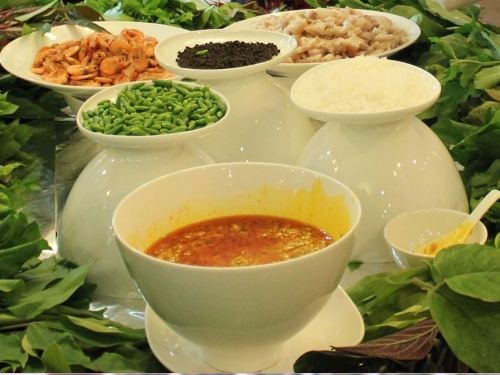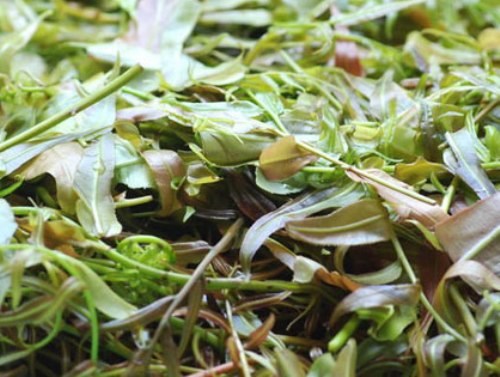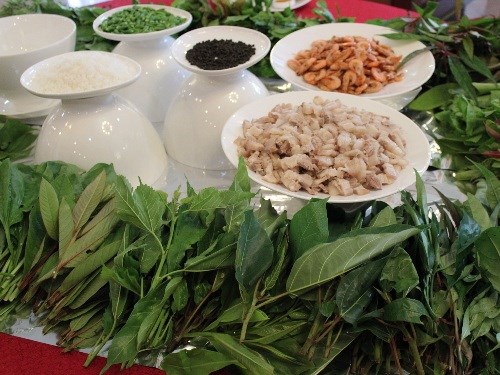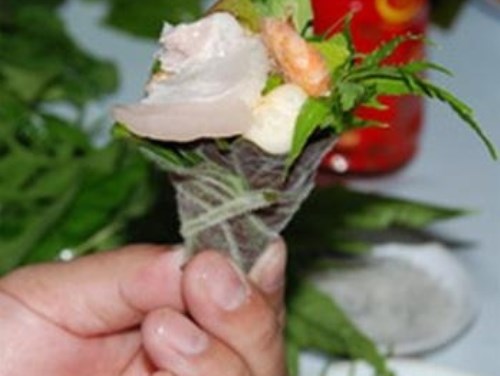With some sliced pork belly, Bi (small sliced pork skin mixed roasted rice powder), and a bit of sautéed shrimps, the meeting of two ex-Truong Son soldiers was still fierily enthusiastic; and the “party of leaves” carried on their good old days.
Kon
Tum, according to Ba Na minority’s language, means “village near a lake”, and
yes, I was standing in front of deep blue, serene Dak Bla river flowing around
gentle Kon Tum city.
Dak
Bla river is totally different from most of other rives in Viet Nam. Usually,
rivers are originated from various places but since they flow into territory of
Vietnam, they will find their ways to Pacific ocean. However, Dak Bla frees
himself against the general trajectory, flows into Cambodia then merge to
Mekong river to the ocean.
Local
people have called it as “river that eats human beings” since Dak Bla can
destroy everything on its fury way but at that moment, all I saw was just a
gentle peaceful river embracing a romantic town. Along river bank to the city
were corn and sugarcane fields.
Across
Dak Bla river is Kon Klor suspension bridge. Standing on Kon Klor we could see
the whole spectacular Dak Bla, even at night with a dangling full moon above.
I
loved quiet musing streets of this village, I love contemplating lively wooden
statues in Mang Den forest (Kon Plong village) which described natural daily
lives of local people, such as one blowing an Olifant, a mom carrying her baby
on her back, pestling grains, carrying water, pregnant women, a man muffled by
a python, beautiful human bodies, and human beings intercourses. Those were the
whole primitive inner world of Highland natives.
Kon
Tum might be a memorial place for many visitors even it is just a quiet tiny
town. Simply the town has its own specialties, such as “leaves festival”.

Wild leaves party.
This
is a name of featured dish, which exactly is a leaves salad. Kon Tum people
explained, “many people gather to have leaves together then we call it leaves
festival”. We could find this salad anywhere in Middle Highland but it
originated in Kon Tum.
There
were several stories of Leaves party’s origin. One of those is that natives
have eaten edible wild leaves with their own meat or fish on the way to work,
not only to feed the stomach but also to use up their natural medicine.
However,
another version is that this dish was first served at Mr. Le Van Nhon’s family
around 1975 when he had an ex-colleague visiting from the North.

Wild leaves.
Mr.
Nhon made up his mind to treat his friend a “leaves meal”, which all leaves
from his backyard, such as mango-pine (Barringtonia acutangula), Sam Dat
(Boerhavia diffusa), Hong Ngoc (Medinilla cummingii), Mo (Paederia lanuginosa),
green mustard, guava, Dinh Lang (Polyscias fruticosa), fig, Piper lolot, Tram
(Syzygium cumini), Ma De (Plantago major), Dap Ca (Houttuynia cordata), basil,
mint, Thuyen Dat (Syzygium polyanthum), purple Nganh Nganh (Cratoxylum
cochinchinense), sour leaves, monkey leaves (Pseuderanthemum palatiferum),
purple E ( Occimum gratissimum), sesame, Kim Cang, Choi Moi (Antidesma
ghaesembilla Gaertn), buffalo tongue (Pentaphragmataceae), Ngai Cuu (Artemisia
vulgaris), Tho Phuc Linh (Talinum paniculatum), ginger, Luoc Vang (Callisia fragrans),
Ngu Gia Bi (Schefflera heptaphylla), dandelion, and bird peppers.

With
some sliced pork belly, Bi (small sliced pork skin mixed roasted rice powder),
and a bit of sautéed shrimps, the meeting of two ex-Truong Son soldiers was
still fierily enthusiastic; and the “party of leaves” carried on their good old
days.
His
friend had left but his dish has stayed with him till now. After several times
making this assorted leaves salads, Mr. Nhon was confident to open a small
restaurant in 1995 to serve this dish.
Other
people said that Mr. Le Van Lam (Dinh Tien Hoang street, Kon Tum province) was
the first one who created and sold this assorted leaves salad. Mr. Lam
originally had assorted wild leaves rolls in Tay Ninh province then he had
varied the recipe with pork and shrimp to bear Kon Tum salad.
I
had arrived Kon Tum in rainy season. My friend took my out to the forest to
prepare assorted leaves salad ourselves. He said that we had to seek and
understand to collect wild leaves, meaning we must know which leaves are edible
and which we should avoid.
We
went along a stream until noon and had a pocketful of over 30 wild leaves. When
I was cleaning the leaves, my friend had cooked other ingredients, such as pork
belly, pork skin, snakehead fish (Channa maculate), and shrimps. He said other
places used many more ingredients like dried seafood, chopping them all then
stir-frying with seasonings.
My
friend preferred his own style with all fresh meat and seafood so that we could
use dipping to taste. Dipping, depending on each style, can be hot sauce, E
salt, or a mixture of chopped shrimps, pork, seasonings, fermented rice, and
oil.
He
gave me a small glass of alcohol, saying, “Take a sip for your stomach. These
are nice leaves, but just in case.” I asked him why not use beer instead of
wine, he smiled and explained, “Beer is from raw yeast. Having leaves and raw
yeast is not a good combination.”

Rolling leaves salad.
We
picked a leaf of each kind, the bigger first then the smaller, rolled the whole
stack into a funnel, filled it up with meat and seafood then just enjoyed. A
mixture of heat, sourness, acridness, bitterness, and spiciness from wild
leaves blending with sweet shrimps, fatty pork, and salted dipping created a
whole highlands’ flavors bursting on the tongue. The leaves party got more
robust with Dinh Lang root soaked in rice wine.
Even
though the assorted leaves salad has been elevated to be on restaurant menu, it
is displayed just as the same as the original slaver, which all leaves are
placed on a big slaver while meat and seafood are at the center so that
everyone can sit around and enjoy the dish.
Having
leaves salad to know Middle Highlands, to understand how Highlands people treat
stomach-ache, high blood pressure, and urolithiaris by wild leaves.
No
matter what the origin of this dish was from the natives, Mr. Nhon, Mr. Lam, or
anyone else, definitely it came from Kon Tum province then spread all over
Middle Highlands and other provinces. Without fire or wild meat, assorted
leaves salad is still dish of forests.
When
I left Kon Tum, my friend handed me a package of all leaves wrapped in banana
leaves as a gift of highlands. He said, “The forests just have leaves to give
out.” Yes, they just need those leaves to express their spirits, and to make
unforgettable memories for visitors.
By V.H/Dantri